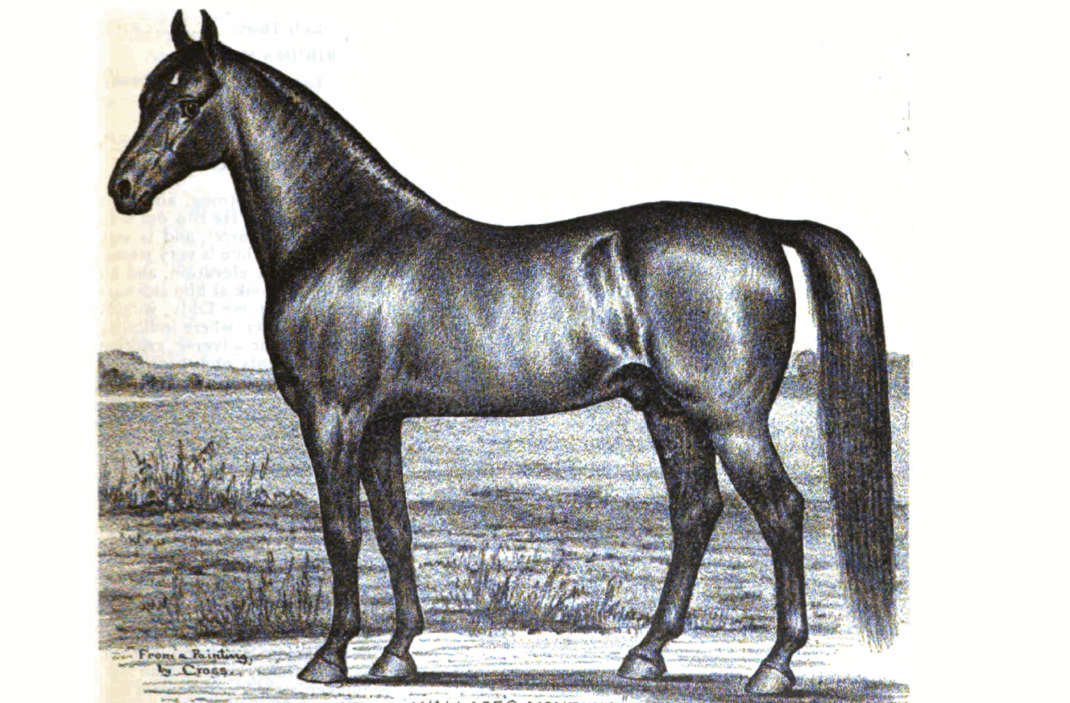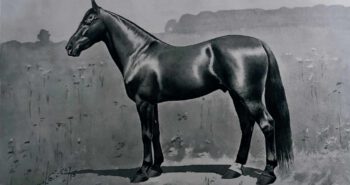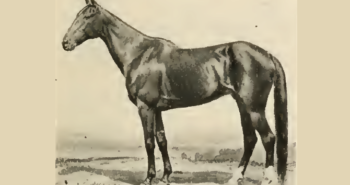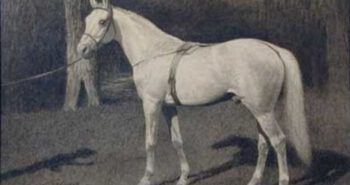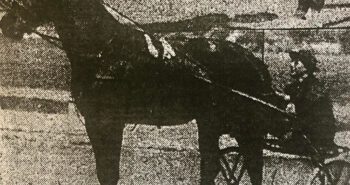She was one of the most famous trotters around the time Hambletonian was born, but we don’t even know her name. In the mid and late 1840s, one gray mare was dominating among the New York roadsters. That was Captain Roberts’ mare. Her name, breeder and pedigree is lost to history – but not her abilities. The unnamed gray wonder founded a family that has thrived throughout trotting history.
In Wallace’s Monthly February 1883, it says “if anyone had spoken of the Captain Roberts Mare among New York horsemen thirty years ago, everybody would have known just what animal was meant. We have not learned that she had any name, but as a road mare she was quite as famous, in her sphere, as Lady Suffolk was in hers, in fact she seems to have been recognized as the mistress of the road, and while her owner, Captain Roberts, was building the High Bridge over the Harlem, this mare was able to take his weight, 250 pounds, either up or down from that work and beat all others with great ease.”
Her then-owner, Captain Samuel Roberts, was one of three contractors for the High Bridge over Harlem River. It was completed in 1848, after which, according to Wallace, “Roberts returned to his farm adjoining Middletown, Orange County, NY, and took the mare with him. He did not live long afterwards, and the mare became the property of his son, Charles.” In fact, Captain Samuel Roberts died on Aug 20, 1848 at “his country seat in Middletown, NY.” According to the little notice in a New York newspaper: “Few men were more extensively known, and none more justly esteemed. In the several relations of husband, father and friend, he fulfilled his duties arising therefrom in such a manner as to win the love and admiration of all who knew him.”
Further information is scant, but Wallace found a later owner of the mare, Sheriff James Hoyt, of Orange County. who stated the she had been engaged “in a good many scrub races, on the road, for small considerations; that she accepted everything that came along, and that she beat everything she started against. The Sheriff seems to think she would have been the Maud S, of her day, under proper treatment.” However, the Captain Roberts mare only raced on the road, otherwise we would have a name, a record and some kind of pedigree.
Wallace repeated the claim that “she was a Messenger mare,” but was quick to iterate that there were no sources and nothing to prove this assertion. Though this claim likely has roots in the truth, to underscore that this was just hearsay, The Breeder and Sportsman in 1904 referred to her as an “inbred Messenger,” while New York Tribune, in an article on Jun 19, 1898, wrote that “from the fact that she was gray in color and a tireless, fast trotter, it was inferred that she may have been a descendant of imported Messenger.” Already around the turn of the century this information was lost, and another 125 or so years since nothing new has been found to firmly establish the pedigree of Captain Robert’s mare. However, when Axtell set several world records in 1889, more information was dug up about Captain Roberts’ mare. According to an article in the Rutland Daily Herald on Jul 17, 1889, the mare “was of the blood of imported Messenger, and was bred on Long Island. She was bought as a new-broken-filly by Capt. Samuel Roberts, at that time a partner with George Law in the contract for building the Croton aqueduct, and a resident of Middletown.” This again fails to substantiate or expand on her pedigree, but Long Island is a vital clue: the place was teeming with sons and daughters (and grandsons and granddaughters) of Messenger.
The above quote also gives some clue to Captain Roberts’ mare’s year of birth. According to Wikipedia, “The Croton Aqueduct or Old Croton Aqueduct was a large and complex water distribution system constructed for New York City between 1837 and 1842.” However, the above-mentioned High Bridge was also seen as a part of the Croton Aqueduct, as it extended it’s reach. We’ve not yet been able to ascertain exactly when Captain Roberts started working on the Aqueduct, but assuming the mare was a 2 or 3-year-old at the time of purchase, and assuming further that she was bought around the time he started working in New York, it seems quite likely the Captain Roberts mare was born in the mid or late 1830s.
The known foals
To further quote from Wallace: “As a road mare she seems to have been greatly distinguished, and when put to breeding she was coupled with some of the best horses in the country. She had a filly by Mambrino Patchen, that was bred to George Wilkes, and a horse colt was the result which Mr. Dunn sold to Mr. Corbitt, of San Francisco, for seven thousand, five hundred dollars. In 1874 she produced Joe Bunker, by George Wilkes, and he has a record, his first season, of 2:20 3/4 (1.27,5). In this family Mr. Dunn has a bonanza.”
The gray mare had three known daughters:
1852 Lady Dunn, by American Star
1853 Susie Roberts, by New York Black Hawk (a son of Long Island Black Hawk)
1862 Miss Hoyt, by New York Black Hawk
The birthyear of Lady Dunn is, by the way, often given as 1855 after Wallace wrote this in his later articles, contrary to his original statements – and without any explanation for the change. According to Wallace’s original statements, however, it was earlier: “Besides the Black Hawk filly, Charles bred her to American Star in 1851, and she produced a grey filly. Upon the death of Charles, this filly was sold to Mr McQuaid, and when she was four years old, FJ Nodine bought her and sold her the next year to Mr Whitney. Upon Mr Whitney’s death, his executors sold her to Mr Wm Dunn, of Cincinnati, Ohio, and she died his, a few years ago.” Charles Roberts died on Jul 25, 1854, so although it is possible that Lady Dunn may have been born in 1855, 1852 seems more likely.
The two daughters by New York Black Hawk both ended up at Charles Backman’s Stony Ford stud, and Susie Roberts’ year of birth is from the Stony Ford catalog of 1870. Susie Roberts had quite a few foals at Stony Ford, mostly by Messenger Duroc, but didn’t produce anybody who excelled either on the track or at stud. The best was Waverly 2:33 (1.35,1), who also stood stud at Stony Ford for most of his life, though with very little results.
Another gray star
Despite Susie Roberts and Miss Hoyt – and potentially unknown foals – not producing, Captain Roberts’ mare founded a family that has stood the test of time. It started with Lady Dunn, whose son Joe Bunker 2:19 1/4 (1.26,5), by George Wilkes, was near undefeatable in 1882 and 1883. The gray gelding born 1874 set his record at Fleetwood, NY on Jun 21, 1883, defeating Director.
The gelding, described as 16 hands high (162,5 cms), had one conformation defect he had inherited from his dam who, in turn, had inherited it from her sire Seely’s American Star. Says Wallace in the Wallace Monthly, “Lady Dunn, the flea-bitten grey daughter of American Star, toed out so excessively in both front feet that no clamps or splints or bandages or surgical operations could ever have straightened her forward limbs. The defect was plainly located in her ankles. Their articulation, instead of being backward and forward in a straight line, was sharply outward. When seen coming down the avenue, up to her full speed, about two minutes and fifty seconds, she seemed to be moving in a straight line, but when jogging her front feet displayed outwardly like the disgruntled paddles of a wrecked windmill revolving out of line. This chronic defect, in her case, she transmitted to her daughter Lady Bunker (…) Joe Bunker, 2:19 1/4 (1.26,5) the best son of Lady Dunn, had the same deformity, by inheritance, to an intensified degree, if that could be possible. He, too, speeded with apparently straightforward action, and never brushed either ankles or knees. But this escape was not owing to his apparently correct forward action. All of the progeny of Lady Dunn, like himself, were exceedingly wide in their chest measurements. The fore limbs seemed to be fastened onto the outside instead of under the carcass. Their peculiarity of conformation enabled them to swing their upturned front feet inwardly, both while jogging and speeding, without either ankle cuffing or knee-banging. The American Star cross, in a purely physical point of view, was not one of pure gold to the composite trotting horse of America. His ankles were not only awry but his knees were sadly sprung, so that to some of his daughters, like Lady Dunn, he bequeathed the curse of deformed ankles (…)”
A great guy
Though Joe Bunker was one of the best horses of his time, it was Lady Dunn’s 1873 foal, Lady Bunker, by Mambrino Patchen, who ensured the family’s growing legacy. Bred at 5, her first foal was the spectacular Guy Wilkes 2:15 1/4 (1.24,1).
In 1885, Wallace described him as “a well balanced combination of excellent points from his head to his heels, and it would be very difficult to pick out a place where you would want to change him. His color is a faultless bay, he is fifteen hands three inches high, and weighs 1,130 pounds (512,5 kgs). In his external form there is not much of the Hambletonian peculiarities about him. He has a beautiful head, well set on to a fine neck of good length and right side up. His shoulders are very strong, and he is high enough on the withers. He ribs out well, making him round in the barrel, and is very deep through the heart. His loin is very strong, his croup is just the right elevation, and his quarters are immense. To look at him sideways we have such a profile as Jerome Eddy, without exuberant style, but lines everywhere indicating solidity and goodness. Our adverse criticism must be confined to two points, and these points are not without their advantages. He is very wide-breasted, throwing his forelegs so far apart that it is just possible this formation may prevent his attaining the highest rate of speed. The other criticism has reference to his hind legs, which are unusually straight. We don’t mean they are too straight for either symmetry, beauty or strength, but they are straighter than the ideal hind leg of a flying trotter, and straighter than the type of the Hambletonian family.”
The colt was bought at 3 by William Corbitt for his San Mateo Stock Farm, which was situated around 18 miles from San Francisco, on the line of the Southern Pacific Railroad, for a price reputed to be a whopping $20,000. Guy Wilkes first stood stud and started in his maiden at San Francisco on Aug 6, 1884. The blue-blooded colt won the race after capturing the second, third and fourth heats in 2:24 1/2, 2:24 3/4 and 2:21 1/2 (1.29,8, 1.30,0 and 1.28,0). The time in the final heat immediately marked Guy Wilkes as one of the fastest stallions, but he was just getting started.
The son of George Wilkes started eleven times that year and won every single time, the fastest in 2:19 1/4 (1.26,5) at San Francisco on Oct 11. The following year he tasted defeat for the first time, winning three of five starts and lowering his record to 2:18 1/2 (1.26,1). He further lowered his record in 1886 in a great season here he only lost once, to Harry Wilkes. At Santa Rosa, on Aug 21, he won the fourth heat in 2:15 1/4 (1.24,1), which wound up being his record. All in all, Guy Wilkes finished his career 18-2-1 in 21 starts and had the remarkable ability to run faster in the concluding heats of a race.
A super stallion
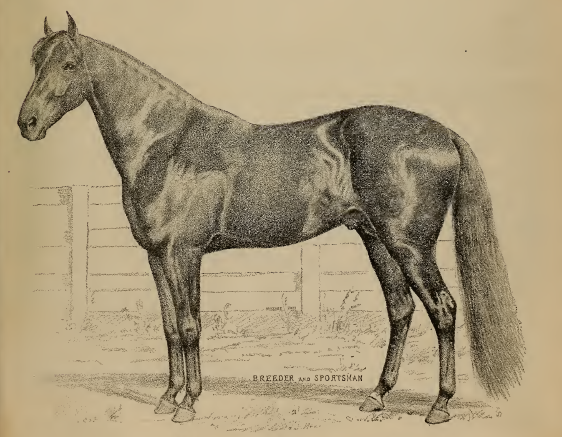
As soon as Guy Wilkes wound down his own racing career, his get was ready to take over. One of his first foals was Sable Wilkes, born 1884. From Sable Wilkes appeared on the track, Guy Wilkes was classed as one of the leading sires. As the get kept impressing on the track, Guy Wilkes became known as “the great horse of San Mateo” and a real money machine for Corbitt: in 1889 his stud fee had grown to $500, in 1892 a massive $1,000.
In the hand of John Goldsmith, Sable Wilkes won as he pleased every single time at 3. At the end of the season, at San Francisco on Oct 29, they decided to try the colt against the world record for the age group. From the San Francisco Chronicle the following day: “The first even on the card was the attempt of Sable Wilkes to beat the three-year-old record 2:19 1/2 (1.26,7), held by Hinda Rose (by Electioneer out of Beautiful Bells), 1883, and by Patron (by Pancoast out of Beatrice), 1885. The cold was driven by John A Goldsmith, and was given the word at the first call, moving along with a graceful, easy motion, and rounding the turn without being eased. The quarter was passed in 35 seconds, and the cold moved along the stretch without a break, passing the half-mile in 1:09 (1.25,8-tempo). Goldsmith urged him a trifle on the upper turn and the three-quarter post passed in 1:44. It was now certain that the record would be broken, and enthusiasm ran high, there being considerable curiosity as to how much Patron’s time would be lowered. Goldsmith found it necessary on the homestretch to cheer the colt a bit, and to use the whip and down the track he came amidst the cheers of the crowd, easing under the wire in 2:18 (1.25,8), thus breaking the world’s record. Goldsmith received a perfect ovation, as the result was due in great part to his driving.”

Sable Wilkes was a good stallion and sired Oro Wilkes, winner of the very first Kentucky Futurity in 1893 for John A Goldsmith. Moreover, Sable Wilkes’ son Freedom was the first yearling to beat 2:30 when he trotted in 2:29 3/4 (1.30,1) in Napa, CA on Oct 18, 1890. Another son of Guy Wilkes who had success at stud was Nutwood Wilkes 2:16 1/2 (1.24,8), though his primary legacy is as the damsire of San Francisco. Guy Wilkes is also the damdamsire of Dillon Axworthy.
Another great Guy
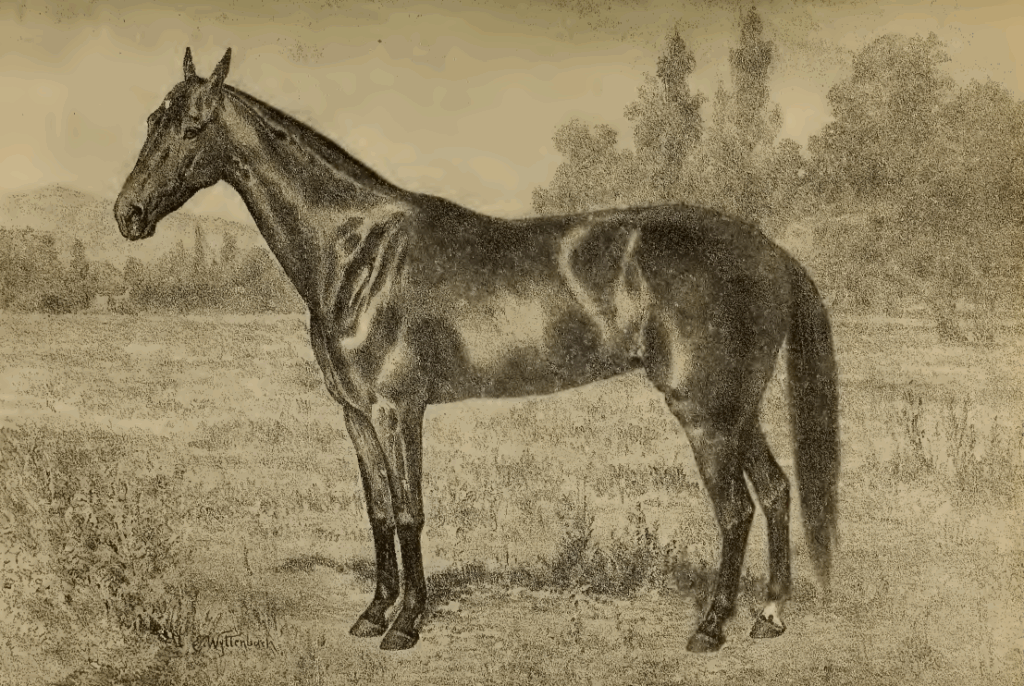
The daughter who ensured Guy Wilkes’ eternal place in trotting history and pedigrees was yet to come, though. Despite her very brief career, world champion Lillian Wilkes, born 1895, may just have been the best and certainly most talented of her sire’s sons and daughters. Bred by Corbitt and the San Mateo Stock Farm, Lillian Wilkes had a short but excellent career on the track. After winning her first race, at the new track in Napa on Aug 15, 1898, the reporter in the Breeders and Sportsman wrote that “a better gaited trotter was never seen on any race track.” She then defeated the world champion Sunol – the only loss anybody ever inflicted on Leland Stanford’s exceptional mare. Lillian Wilkes won that race fair and square, too, grinding down Sunol in the last three heats. Moreover, her 2:17 3/4 (1.25,6) winning time was a world record for 3-year-old fillies. Later in the season she severe sprained a front foot and was laid up for the season. She never made it back to the track, and retired after being 2-0-1 in 3 starts.
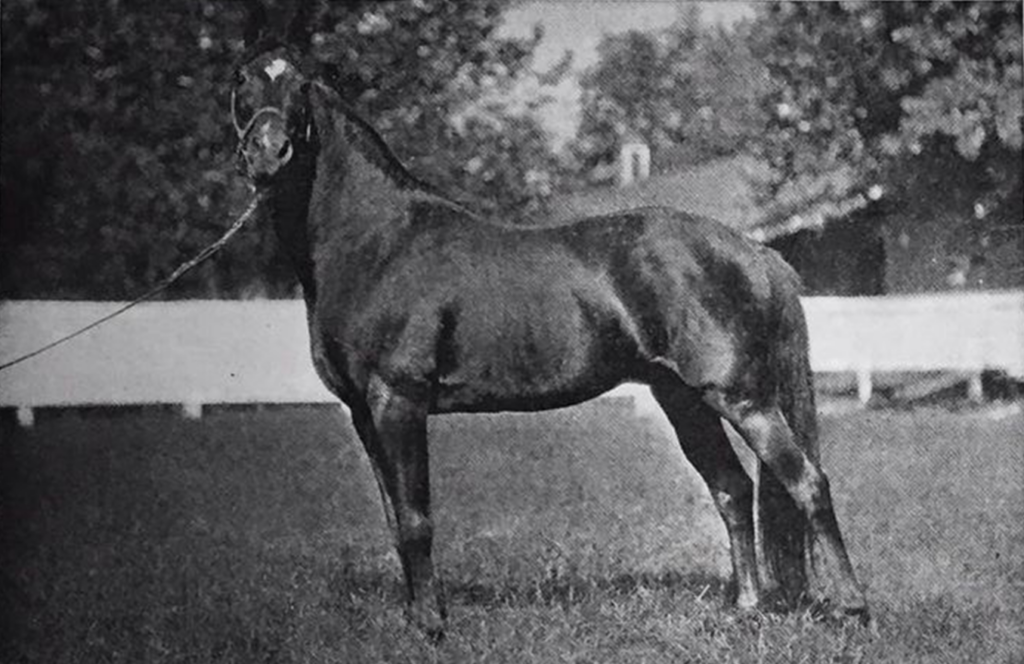
In the shadows of Guy Wilkes was his full brother William L, a horse who struggled with poor feet. However, the latter would claim his fame through his son Axtell, who in turned sired the foundation stallion Axworthy. In 1901, Axworthy was bred to Lillian Wilkes, producing Guy Axworthy. The latter had the unusual pedigree pattern of two full brothers, William L and Guy Wilkes, as paternal great-grandsire and maternal grandsire, respectively.
Decline and recovery
Despite making a fortune on both Guy Wilkes and Sable Wilkes, Corbitt lost a lot of money on non-breeding ventures during the depression of the 1890s. He eventually decided to sell out, and in February 1897, Guy Wilkes went through the ring at the Madison Square Garden during Peter Kellogg’s combination sale. The price ended up a meagre $5,000, reflecting the colt’s poor physical condition as he had not been kept well for several years owing to Corbitt’s financial woes. Despite expectations of a price in the $12,000-$15,000 range, bidding stopped at just $5,000. Buyer was WJ White for his Two Minute Stock Farm in Rockport, OH, just outside Cleveland. In the same sale, Sable Wilkes was sold for $1,900.
Just two months after the auction, local newspapers in Cleveland reported that Guy Wilkes had made a recovery after his teeth being operated upon; the colt had started eating and quickly regained his strength. Unfortunately, four year later the colt died at the Two Minute Stock Farm on Sep 19, 1900. At the time of his death, Guy Wilkes was one of the best stallions the trotting world had ever seen.
Modern stars
The family didn’t stop there. Guy Wilkes’ sister Welcome Bunker, by Mambrino King, is the great grandam of Charm, fourth in the 1926 Hambletonian. Two branches from Charm survives to the present day. One is down to Emmylou Who, her daughter Emoticon Hanover, in turn the dam of Emoticon Legacy.
The other is through Charm’s daughter Farr, by Truax, second (split with DeSota) in the 1937 Hambletonian. Farr is a maternal descendant of world champion Designed to Be and her great son Greenshoe. From it’s gray and humble beginnings on the streets of New York in the 1840, the maternal family of Captain Roberts’ mare has continued to produce top trotters – and it doesn’t seem to be done just yet.
Guy wilkes
Bay colt born in Cincinnati, OH on Aug 2, 1879. Died in Rockport, OH, on Sep 19, 1900.
George Wilkes – Lady Bunker (Mambrino Patchen)
21 starts: 18-2-1 – 2:15 1/4 (1.24,1)
Breeder: William Dunn
Owners: William Dunn – William Corbitt/San Mateo Stock Farm – WJ White/Two Minute Stock Farm
Trainer: John A Goldsmith
Driver: John A Goldsmith
Groom:

